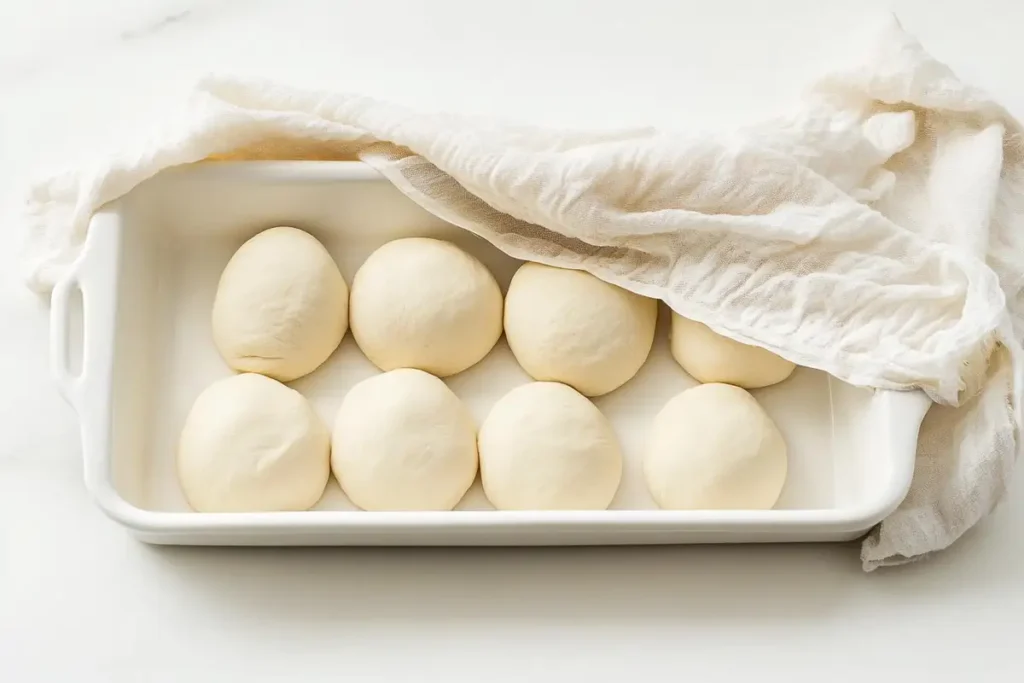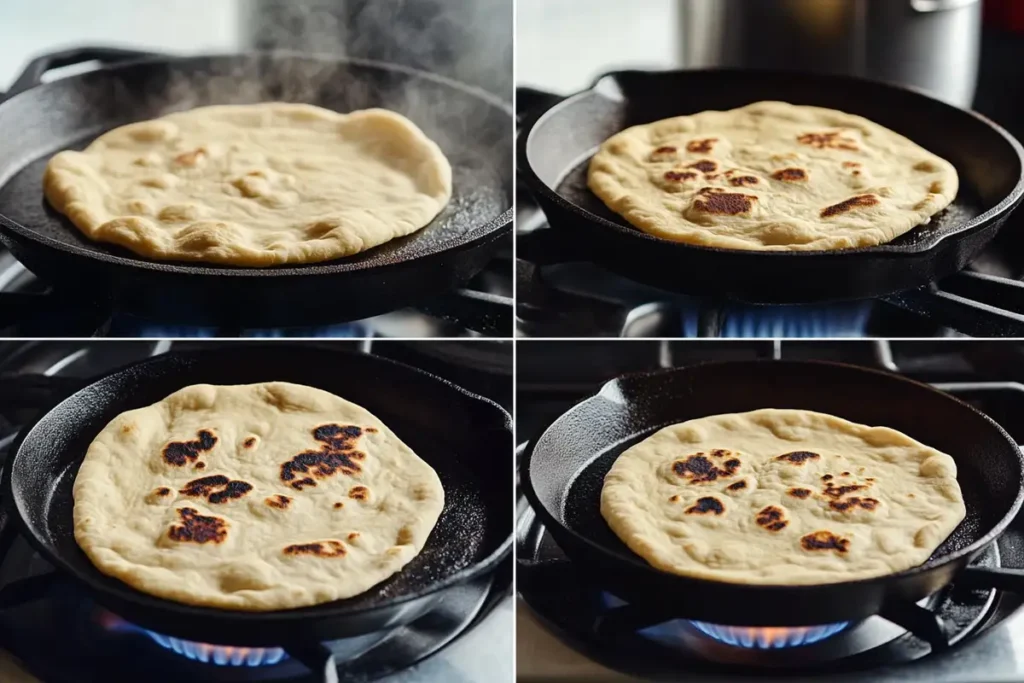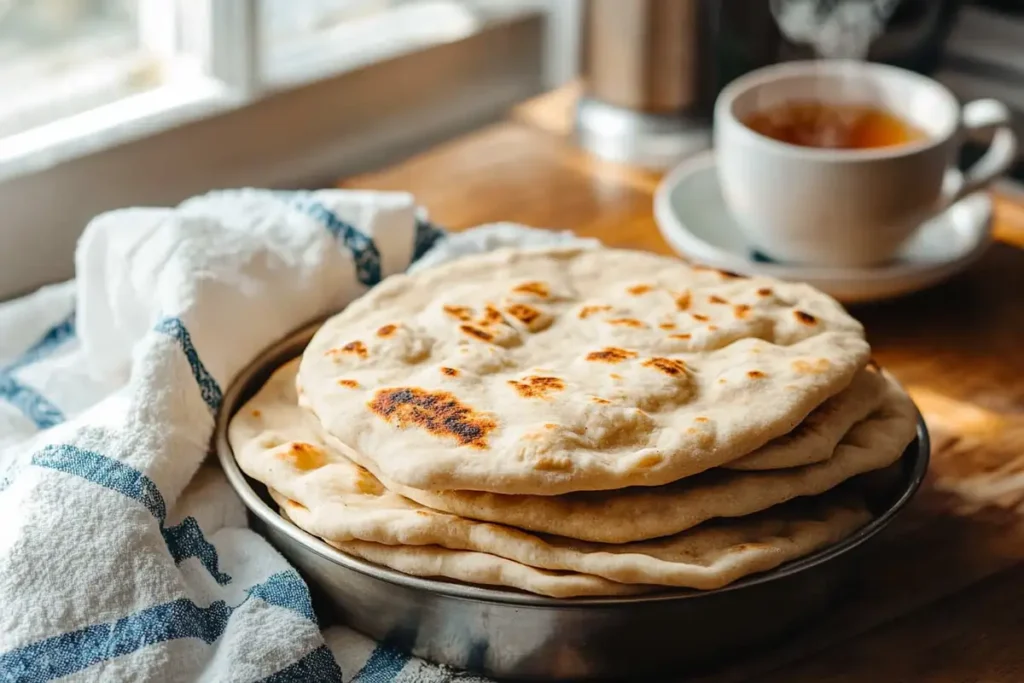Introduction Sourdough Discard Naan
There’s something magical about the combination of sourdough discard and naan bread. While one represents sustainability and avoiding waste, the other is an ancient flatbread cherished across the globe. But have you ever thought about combining them? Oh, the result is nothing short of spectacular! This article will take you on a journey into making sourdough discard naan—from understanding the ingredients and preparation to cooking techniques and serving suggestions. We’ll cover everything you need to know, so whether you’re a beginner or an experienced baker, you’ll be ready to whip up some soft, chewy, and slightly tangy naan right at home.
Table of Contents
What is Sourdough Discard?
At its core, sourdough discard is the portion of sourdough starter that’s removed before feeding the remaining starter with fresh flour and water. Many bakers toss it out, thinking it’s just excess waste. But, oh boy, they’re missing out! This ‘discard’ is a versatile ingredient that can elevate your recipes to extraordinary heights. Think pancakes, crackers, pizza dough, and naan bread. It’s not just about avoiding waste, it’s about unleashing your creativity in the kitchen.
Using sourdough discard isn’t just about avoiding waste; it’s about embracing resourcefulness and sustainability. Its tangy essence and subtle complexity add a signature twist to traditional recipes. Plus, it brings natural fermentation benefits, which are excellent for gut health. Who knew leftovers could taste so good, right?
What is Naan?

Ah, naan! Just the word conjures up images of warm, fluffy flatbreads served fresh from a tandoor oven, glistening with melted butter and sprinkled with herbs. Naan bread is a traditional South Asian flatbread, particularly popular in Indian, Pakistani, and Afghan cuisines. Made with a soft dough enriched with yogurt, milk, or eggs, naan boasts a pillowy texture and a slightly chewy bite.
Traditionally, naan is cooked in a tandoor—a clay oven fired by wood or charcoal. The high heat creates those characteristic bubbles and golden-brown charred spots we all adore. However, fear not! Using a skillet or griddle, you can replicate similar results in your home kitchen.
When combined with sourdough discard, naan transforms into something even more delightful—a fusion of tradition and sustainability. The discard’s tangy undertones complement the naan’s soft texture beautifully, making each bite an experience to savor.
Benefits of Using Sourdough Discard in Naan
Enhanced Flavor Profile
When it comes to sourdough, discard naan; the magic lies in the flavor. Sourdough discard brings a tangy, slightly sour note that perfectly complements naan’s soft, pillowy texture. This natural acidity doesn’t overpower; instead, it subtly enhances the bread’s overall taste, giving it a depth you can’t achieve with traditional yeast.
Additionally, the fermentation process in sourdough breaks down some of the flour’s natural sugars, resulting in a more complex and balanced flavor. It’s like the difference between instant coffee and a slow-brewed espresso—both do the job, but one outshines the other.
Seasoned bakers don’t just appreciate this flavor boost; even first-time naan enthusiasts notice the difference. And honestly, once you’ve tasted naan made with sourdough discard, it’s hard to return to regular recipes.
Improved Texture and Softness
Ah, texture! A good naan isn’t just about taste; it’s about how it feels when you tear into it. Using sourdough discard in naan contributes to a softer, more elastic dough. Thanks to the natural fermentation process, the gluten structure becomes more developed, creating a chewy bread in all the right ways.
Additionally, the organic acids in sourdough act as natural dough conditioners. They help retain moisture in the naan, ensuring it stays soft and fluffy even hours after cooking. Say goodbye to dry, cardboard-like naan that crumbles after reheating!
And here’s the kicker: sourdough discard naan also has better digestibility. The fermentation process breaks down phytic acid in the flour, making the nutrients easier to absorb. So your naan tastes better, and your gut thanks you for it, too. It’s a win-win scenario where flavor meets functionality, and you can feel good about what you’re eating.
It is one of those win-win scenarios where flavor meets functionality—an edible masterpiece born out of simplicity and a touch of science.
Ingredients Needed for Sourdough Discard Naan
Essential Ingredients

Making sourdough discard naan doesn’t require a long list of fancy ingredients. You probably have most of them in your pantry right now. Here’s what you’ll need:
- Sourdough Discard: The star of the show! Preferably unfed and at room temperature.
- All-Purpose Flour: Provides the perfect balance of softness and structure.
- Yogurt: Adds richness and tenderness to the dough.
- Milk (or Water): Helps bring the dough together and keeps it soft.
- Olive Oil (or Ghee): Adds moisture and flavor.
- Sugar: Just a touch to balance the sourness of the discard.
- Salt: Enhances flavor and strengthens the dough structure.
- Baking Powder (optional): Helps with extra fluffiness if you’re skipping long fermentation.
These basic ingredients come together to create something truly magical. And honestly, there’s a certain satisfaction in turning pantry staples into restaurant-quality naan right in your kitchen.
Optional Add-ins and Variations
Oh, but the fun doesn’t stop at the basics! Once you’ve mastered the classic sourdough discard naan, you can get creative with optional add-ins:
- Garlic: Minced and mixed into the dough or brushed on top after cooking.
- Herbs: Fresh cilantro, parsley, or even chives.
- Cheese: Stuff the naan with mozzarella or paneer for a cheesy surprise.
- Spices: A sprinkle of cumin seeds, nigella seeds, or smoked paprika.
- Butter or Ghee Finish: Brush melted butter or ghee over freshly cooked naan, which takes it to the next level.
The beauty of naan lies in its versatility. Whether you’re keeping it classic or experimenting with bold flavors, sourdough discard naan is your blank canvas.
So, gather your ingredients, prep your kitchen, and move on to the step-by-step guide in the next section. Trust me—you’re about to fall in love with homemade naan!
Step-by-Step Guide to Making Sourdough Discard Naan
Preparing the Dough
Alright, let’s roll up our sleeves—it’s dough time! The foundation of sourdough discard naan starts with a well-prepared dough.
- Combine the Ingredients: In a large mixing bowl, combine sourdough discard, flour, yogurt, milk, olive oil, sugar, and salt. If you’re using baking powder, add it now.
- Mix to Form a Dough: Stir the ingredients until they come together. Once it looks shaggy, switch to your hands and knead it into a smooth ball.
- Adjust the Texture: If the dough feels too sticky, sprinkle in a little flour. Too dry? Add a splash of milk or Water. The dough should be soft and slightly tacky but not overly sticky.
- Rest the Dough: Cover the bowl with a damp towel and let it rest for at least 2 hours. For a deeper flavor, let it ferment in the fridge overnight.
This resting phase is where the magic happens! The sourdough discard works its fermentation charm, developing those complex flavors we love.
Fermentation and Proofing
Fermentation is where sourdough discards naan and gets its signature tang and softness. Patience here pays off!
- If you’ve left the dough at room temperature, aim for about 2–3 hours until it doubles in size.
- If you’re proofing overnight in the fridge, let the dough return to room temperature before shaping.
Fermentation allows natural yeast and bacteria in the sourdough to break down gluten, improving texture and digestibility.
Pro tip: Don’t rush this step! Good things take time, and your naan will thank you later.
Shaping and Cooking the Naan
Now comes the fun part—shaping and cooking!

- Divide the Dough: Split your dough into equal portions. Roll each piece into a smooth ball.
- Shape the Naan: Roll each dough ball into an oval or round shape, about ¼ inch thick, on a floured surface.
- Preheat Your Skillet: Heat a heavy skillet or griddle over medium-high heat. It should be screaming hot before you start cooking.
- Cook the Naan: Place one naan on the skillet. Cook until bubbles form on the surface and the bottom develops golden brown spots. Flip and cook the other side for another minute or so.
- Butter It Up: Brush the hot naan with melted butter or ghee and sprinkle with fresh herbs if desired.
And there you have it—perfectly cooked sourdough discard naan! Soft, chewy, and bursting with flavor.
Tips and Tricks for Perfect Naan
Achieving the Right Consistency
Naan dough can be a bit finicky, but consistency is everything.
- Soft but Not Sticky: The dough should be pliable but not stick to your hands excessively. If it’s too wet, add small amounts of flour. If it is too dry, a splash of milk can work wonders.
- Rest is Best: Allow the dough to rest for at least 2 hours. Overnight fermentation is even better for flavor development.
- Handle with Care: Be gentle when rolling out the dough. Overworking can lead to tough naan.
If you’re unsure about dough texture, trust your instincts. Dough speaks—soft, elastic, and slightly tacky is the sweet spot.
Cooking Techniques for Optimal Results

The way you cook naan can make or break the final product. Here are some key techniques to ensure success:
- High Heat is Key: Your skillet or griddle must be hot. This mimics the intense heat of a traditional tandoor oven.
- One at a Time: Cook naan one at a time for even heat distribution.
- Keep it Covered: If your naan isn’t puffing up, briefly cover it with a lid while cooking. The trapped steam can work wonders.
- Don’t Skip the Butter: After cooking, a generous brushing of melted butter or ghee adds flavor and keeps the naan soft.
With these tips in your back pocket, every naan you make will be a masterpiece—golden, bubbly, and melt-in-your-mouth delicious.
Serving Suggestions and Pairings
Traditional Accompaniments

Naan bread has long been a staple in South Asian cuisine, and it pairs beautifully with a wide array of dishes. The tangy undertones of sourdough discard naan elevate classic pairings, creating a delightful culinary experience.
- Curries: Whether it’s creamy butter chicken, spicy chicken tikka masala, or a hearty chana masala, naan is the perfect vessel to scoop up those rich, flavorful sauces.
- Dal (Lentils): Pair your naan with a warm dal tadka or makhani bowl. The softness of naan balances the earthy richness of lentils effortlessly.
- Kebabs and Grilled Meats: Serve naan with smoky kebabs, tandoori chicken, or grilled lamb. The charred flavor of grilled meat complements the soft, tangy bread beautifully.
- Raita: This cool, yogurt-based side dish contrasts the robust flavors of naan and curry.
The versatility of sourdough discard naan allows it to shine across various traditional dishes, enhancing every bite with its soft, tangy texture.
Creative Serving Ideas
Why stop at traditional pairings? Sourdough discard naan is incredibly versatile and can be transformed into creative culinary masterpieces. Here are some fun serving ideas:
- Naan Pizza: Use naan as a pizza base. Top with tomato sauce, mozzarella cheese, fresh basil, and your favorite toppings. Bake until bubbly—voila! Instant pizza.
- Naan Wraps: Fill warm naan with grilled chicken, fresh veggies, and a drizzle of tzatziki sauce for a quick and satisfying wrap.
- Naan with Hummus: Tear naan into pieces and serve it alongside a bowl of creamy hummus. Add olives and cherry tomatoes for a Mediterranean twist.
- Naan Breakfast Sandwich: Stuff naan with scrambled eggs, crispy bacon, and avocado for a hearty breakfast treat.
- Garlic Naan Bites: Brush mini naans with garlic butter, sprinkle some herbs, and serve as an appetizer at your next gathering.
The beauty of sourdough discard naan lies in its adaptability—it’s not just a side dish; it’s a canvas for your creativity.
Storing and Reheating Sourdough Naan
Proper Storage Methods

So, you’ve made a big batch of sourdough discard naan—congratulations! But what now? Proper storage is key to keeping your naan fresh and delicious.
- At Room Temperature: Store leftover naan in an airtight container or resealable plastic bag. It will stay fresh for up to 2 days.
- In the Refrigerator: For longer storage, wrap naan tightly in foil or plastic wrap and store it in the fridge for up to 5 days.
- Freezing Naan: Naan freezes exceptionally well. Place pieces in a freezer bag, separating each with parchment paper to prevent sticking. Frozen naan can last up to 2 months.
Pro Tip: Always allow naan to cool completely before storing to prevent condensation and sogginess.
Reheating Techniques
Reheating naan isn’t just about warming it up—it’s about reviving its soft, pillowy texture. Here’s how:
- On the Stovetop: Heat a skillet over medium heat and warm the naan for 1-2 minutes on each side. Brush with butter for added softness.
- In the Oven: Preheat the oven to 350°F (175°C). Wrap naan in foil and heat for about 5-7 minutes.
- In the Microwave: Place naan on a microwave-safe plate, cover with a damp paper towel, and heat for 20-30 seconds.
Avoid overheating, as it can make naan dry and rubbery. After reheating, a light brush of butter or ghee works wonders in restoring its original flavor and texture.
Following these simple storage and reheating tips, you can enjoy fresh-tasting sourdough discard naan anytime—whether straight from the skillet or reheated days later.
Next, we’ll tackle frequently asked questions to address common doubts and ensure your naan-making journey is as smooth as possible. Stay tuned!
Frequently Asked Questions
Can I Use Active Sourdough Starter Instead of Discard?
Absolutely! While sourdough discard is typically unfed and has a tangier profile, an active starter can also be used. However, remember that an active starter will produce a slightly less tangy flavor and might cause the dough to rise more quickly. If you’re using an active starter, adjust proofing times accordingly, as the yeast activity will be stronger.
Can I Make Naan Without Yogurt?
Yes, you can! While yogurt adds softness and a slightly tangy flavor to naan, you can substitute it with other ingredients. Use buttermilk, coconut yogurt, milk, and lemon juice as an alternative. Just ensure the substitute maintains the dough’s hydration and richness.
What Flour is Best for Naan?
The most common choice for naan is all-purpose flour. It balances softness and elasticity, which is perfect for sourdough discard naan. If you want a slightly chewier texture, you can use bread flour. For a nuttier flavor, experiment with whole wheat flour—keep in mind it will yield a denser naan.
How Do I Prevent Naan from Becoming Too Dry?
Dry naan can be a bummer, but it’s easy to prevent:
Don’t Overcook It: Cooking naan for too long or low heat can dry it out.
Butter is Your Best Friend: Always brush freshly cooked naan with melted butter or ghee.
Store Properly: Keep naan wrapped in a clean kitchen towel or airtight container until serving.

